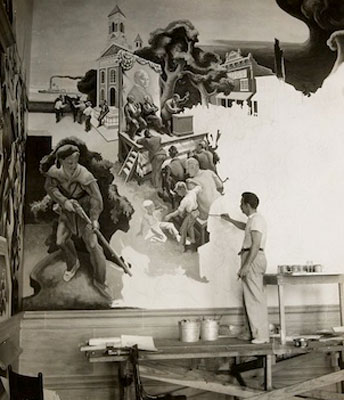Last updated: October 12, 2021
Lesson Plan
Missouri Capitol Mural 3rd & 4th Grade

- Grade Level:
- Upper Elementary: Third Grade through Fifth Grade
- Subject:
- Social Studies
- Lesson Duration:
- 60 Minutes
- State Standards:
- Missouri: #6 Knowledge of relationships of the individual & groups to institutions and cultural traditions.
.Kansas: KCCRS .4.3: Recognize historical perspective - Additional Standards:
- Oklahoma: 4.3.2.A: Identify the characteristics of culture and compare the cultural characteristics of different regions of the U.S.
- Thinking Skills:
- Remembering: Recalling or recognizing information ideas, and principles. Understanding: Understand the main idea of material heard, viewed, or read. Interpret or summarize the ideas in own words. Applying: Apply an abstract idea in a concrete situation to solve a problem or relate it to a prior experience. Analyzing: Break down a concept or idea into parts and show the relationships among the parts. Creating: Bring together parts (elements, compounds) of knowledge to form a whole and build relationships for NEW situations. Evaluating: Make informed judgements about the value of ideas or materials. Use standards and criteria to support opinions and views.
Essential Question
How is art used to impact the views of society?
Objective
Students will be able to determined how to "read" visual representations of art and connect them to the concepts that art depicts.
Student Friendly Objective - I will be able to identify various ideas conveyed by the Missouri State Capitol Mural.
Background
Background of Thomas Hart Benton
Show video: Moments in Missouri Political History Video Segments: Thomas Hart Benton, 39 sec., courtesy of Secretary of State of Missouri
Article, biography, examples of Benton's works.
The Capitol, Jefferson City and other works by Thomas Hart Benton, courtesy of the archives of Missouri Life Magazine
Mark Twain; Frankie & Johnny; Ragtime Music; Mormon Expulsion; Thomas Joseph Pendergast; portions of Thomas Hart Benton's Missouri State Capitol Mural, "Social History of Missouri"
Preparation
Show Moments in Missouri Political History Video Segments: Thomas Hart Benton, 39 sec., courtesy of Secretary of State of Missouri
Article, biography, examples of Benton's works.
The Capitol, Jefferson City and other works by Thomas Hart Benton, courtesy of the archives of Missouri Life Magazine
Show: Mark Twain
Frankie and Johnny audio - 2:52, Frankie & Johnny by Jimmie Rodgers, 1929
Show Mormon Expulsion
Show on Smartboar if available: Workers of Missouri, farmers, industrial; Frankie and Johnny; Industrial, courtroom, farmer, Jesse James; Tom Sawyer and Huck Finn, white traders and Indian; Boss Tom Pendergast, Frankie and Johnny; Political speech, baby being changed; Kansas City stockyards;Frank and Jesse James
Materials
Lesson Hook/Preview
Ask students to name art pieces that they have seen (do not limit the format: sculptures, statues, paintings, murals, etc.) or where/how (social media/tv/in person). From the list created by students (feel free to add your own examples in order to fill any gaps) show a visual of the art listed and ask them to create an observation list of at least five (5) things they see that are similar in the art. Then ask them what they think the time was like in the pieces shown. Ask them what clues were in the art that drove them to their hypothesis/best guesses.
Procedure
Give students background of Thomas Hart Benton: On Smartboard if available show: Moments in Missouri Political History Video Segments: Thomas Hart Benton, 39 sec.; courtesy of Secretary of State of Missouri
On Smartboard show article, biography, examples of Benton's works, image courtesy of the archives of Missouri Life Magazine
On Smartboard show: Mark Twain
Listen to Frankie & Johnny audio, 2:52
On Smartboard show video: Mormon Expulsion
On Smartboard show various portions of Thomas Hart Benton's Missouri State Capitol Mural, "Social History of Missouri"
a) Workers of Missouri, farmers, industrial
b)Frankie and Johnny
c)Industrial, courtroom, farmer, Jesse James
d)Tom Sawyer and Huck Finn, white trader and Indian
e)Boss Tom Pendergast, Frankie and Johnny
f)Political speech, baby being changed
g) Kansas City stockyards
h) Frank and Jesse James
Ask students:
1) What is the difference between a mural and a painting?
a) Show 1904 World's Fair Poster by Alphonse Mucha,
b) Mural created by Dave Loewenstein, courtesy of Debra Parrish
2) Ask students to identify WHY art is created? (List reasons)
Discuss who Thomas Hart Benton was and what he was asked to do for the capitol of Missouri; show video on legislature commissioning Benton for the mural.
3) Show the murals from the Missouri state capitol by Thomas Hart Benton share with students the document called: Reactions (Google Doc), or Reactions (Microsoft Word Version) Have students work in pairs or independently to respond to the prompts.
Follow up question: How does learning about art impact how we perceive the world?
Vocabulary
Thomas Joseph Pendergast - (July 22, 1872 - January 26, 1945), also known as T.J. Pendergast, was an American political boss who controlled Kansas City and Jackson County, Missouri, from 1925 to 1939.
Ragtime Music 1) rhythm characterized by strong syncopation in the melody with a regularly accented accompaniment in stride-piano style. 2) music having ragtime rhythm.
Supports for Struggling Learners
For students that are struggling with comparisons:
1) What colors do you see first?
2) What images are the largest?
3) What images are the smallest?
4) Why do you think the artist chose the colors and positions and images the way it was done?
5)How would you improve the piece? (What would you add or take away?) How would your alterations make the art more memorable, powerful or accurate?
Enrichment Activities
Have students create their own version of a mural similar in style to Thomas Hart Benton.
Suggest that a new section of the Missouri State Capitol is being built and they have been commissioned to contribute art. They are free to construct any visual type of art they see fit. Have them include a written explanation of:
Their intended message.
Why they chose the images they did?
The hope that they want those that see their art to fee/do.
